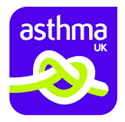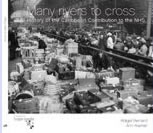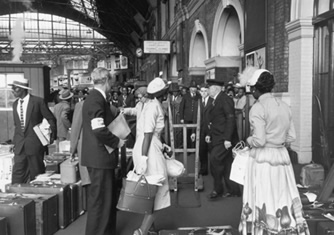 |
A British Council worker helps a
West Indian immigrant along the platform at Victoria Station, 9 June 1956. © Photo by Haywood Magee/Picture Post/Hulton Archive/Getty Images |
Many Rivers to Cross
In 1945 World War Two finally ended. In Britain, a Labour government came to power, with a programme of radical social reforms that would create a welfare state for postwar Britain. Central to these reforms was the National Health Service (NHS) – the world’s first comprehensive health service, which provided health care free for every British citizen, according to need rather than means.
On 5 July 1948 the National Health Service came into being. The government became caretaker of 2,688 hospitals – 1,143 voluntary hospitals providing some 90,000 beds and 1,545 municipal hospitals with about 390,000 beds, of which 190,000 were in hospitals for the mentally ill. The NHS was launched as a single organisation based on 14 regional hospital boards. There were three parts: hospital services; family doctors, dentists, opticians and pharmacists; and local authority health services, including community nursing and health visiting. Immediately, millions signed on with a doctor. Inpatient care soared from 2.9 million people in 1949 to 3.5 million in 1953, while outpatient care rose from 6.1 million people in 1949 to 6.7 million in 1953.
Difficulties and labour shortages
The new NHS was far more costly than anyone could have expected but there was a wish for it to succeed. The government’s first priority was to reorganise the hospitals. However, Britain was suffering the after-effects of war: food was rationed, the economy needed rebuilding and bomb damage meant resources were needed to build new homes rather than new hospitals. There was also a serious labour shortage. To rebuild the country, Britain needed more workers, particularly in low-paid jobs that white British people were not willing to do. The new health service was no exception. It was desperately short of staff – nurses, midwives, ancillary workers, cleaners, cooks and porters.
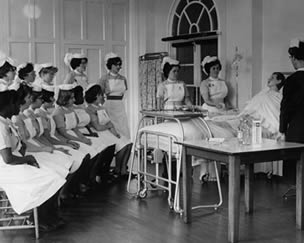 |
Nurses’ practical classroom, Mile End Hospital, c1960s (Royal London Hospital Archives: ME/P/19) |
An urgent national need
In 1945 a government report produced by Aneurin Bevan and others – Staffing the Hospitals: An Urgent National Need – highlighted a ‘woeful’ shortage of nursing staff. According to the report there was an immediate need for at least 30,000 more nurses and midwives and about 12,000 domestic and other hospital workers. Without them the new NHS would not be able to function.
Recruitment drives
From 1948 the British government funded recruitment drives to attract qualified nurses, trainees, domestic workers and others into the hospitals. For the first time, the book Many Rivers to Cross documents the stories of the very first people to come from the Caribbean to work in the NHS.
Recruitment took place in Britain and overseas. The response from British-born women was poor. More than 700 vacancies were advertised in Tottenham, for instance, but there were only 17 enquiries. During the war women had flocked to nursing as part of the war effort.
Afterwards most married women returned to the home. Young, single, British-born women were more interested in taking up better-paid opportunities that were opening up to women, such as secretarial work, teaching or work in the civil service. Nursing, with its long hours, low pay and strict discipline, was far less appealing.
Recruiting from the
Caribbean
In 1949 the Ministries of Health and Labour, together with the Colonial Office, the General Nursing Council (GNC) and the Royal College of Nursing (RCN), began a deliberate policy of recruiting from the British colonies, particularly the West Indies. Recruitment was aimed at three main categories of workers: hospital auxiliary staff (orderlies, receptionists, cooks, pantry workers, and telephonists), nurses or trainee nurses, and domestic workers, such as laundry workers.
From the late 1940s and throughout the 1950s, advertisements appeared in the nursing press encouraging applicants from the colonies. In the Caribbean, newspapers such as the Barbados Advocate or Barbados Beacon ran advertisements inviting young women students to apply to train as nurses in Britain. There were also advertisements for ward orderlies, cooks, maids and other domestic staff. In 1949, for instance, the Barbados Beacon advertised for 31 women to work as nursing auxiliaries in hospitals in Bristol, Cardiff, Dartford, Edinburgh, Lincolnshire, Loughborough, Manchester and North Staffordshire. Candidates had to be aged 18 to 30, literate and prepared to sign a three-year contract.
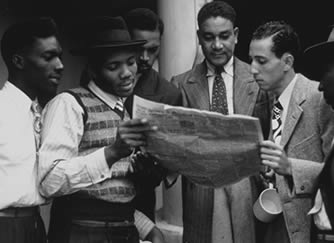 |
Charlie Gomm, LT Recruitment Officer, seen interviewing the first batch of Caribbean applicants for work with London Transport, Barbados, 1956.
Courtesy of London Transport Museum © Transport For London. |
Working together
For Britain, the colonies were an important source of much-needed nurses and ancillary workers. Senior British matrons went to the Caribbean to recruit nurses. So too did Enoch Powell, who later became notorious for his attacks on black immigrants. In 1951 Florence Udell, Colonial Office Chief Nursing Officer (COCNO), went to the Caribbean to meet with senior nursing officers. Colonial governors, the Ministries of Health and Labour and the Colonial Office worked together to recruit and select women workers for employment in British hospitals. The aim of recruitment policy in Britain and the Caribbean was to fill vacancies in British hospitals but also to train nurses who would return to the Caribbean to help develop health services there.
Selection procedures
By 1955, 16 British colonies had set up selection and recruitment procedures to ensure a steady flow of colonial nursing candidates for the NHS. Within the Caribbean, there were official recruitment schemes in Barbados, British Guiana (now Guyana), Jamaica, the Leeward Islands (Antigua, Montserrat and St Kitts), Trinidad & Tobago and the Windward Islands (Dominica, Grenada, St Lucia and St Vincent). Individual British hospitals as well as regional hospital boards often advertised directly for staff. In 1956, for instance, the South-West Metropolitan Regional Hospital Board put out a request for ‘West Indians as nursing auxiliaries, nursing assistants and possibly student nurses’ who could be placed in specially selected hospitals.
Caribbean women wishing to apply for nurse training in Britain had to be aged 19–30, qualified to matriculation level (equivalent to today’s GCSEs) and English-speaking. Typically, a candidate either responded to an advertisement or applied directly to matrons in NHS hospitals in Britain. Candidates put in a written application, which went to a selection board together with testimonials or references. Successful applicants were interviewed and some had to do a short General Nursing Council-approved preliminary training course. Application forms were sent to the Colonial Office in Britain for approval. There was some government sponsorship but most recruits, or more usually their parents, had to pay their own fares and training expenses. From 1955 the British government offered loans for help with travel but recruits had to pay these back at a certain amount per week.
To Read Many Rivers to Cross in full visit: www.manyriverstocross.co.uk
Back: Health UK |

